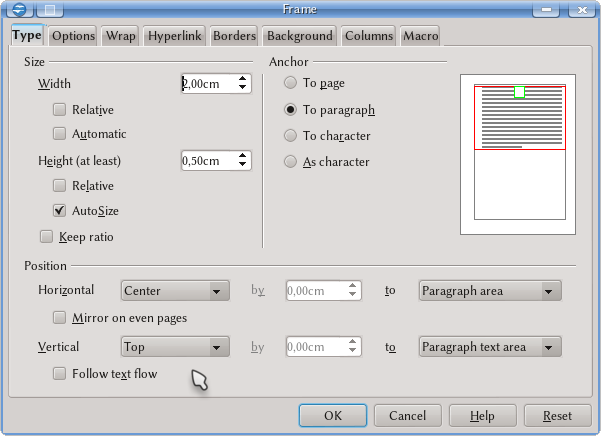Working with frames on Writer
Template:Documentation/DraftPage
Contents
Inserting a Frame
For those readers with some knowledge of LaTeX, frames on Writer are similar to LaTeX "minipages". Basically, a frame is a small "floating page" on top of a real page. Frames accept any kind of content, like text, pictures, tables... even other frames.
Frames are used extensively on Writer: each inserted picture, each OLE object (Math objects, charts...) are inside a frame. When a caption is added to a picture, this picture, which is already inside a frame, will be automatically included on another frame that enclose the paragraph with the automatic numbering.
Type tab
On top of this tab, to the left it is possible to define the Frame size, where "Relative" means "Relative to the text area" while "Automatic" (for Width) and "AutoSize" (for height) makes the frame grow with the content.
The option "Keep ratio" force width and heigh of the frame to grow proportionally.
On the top right it is possible to choose the "Anchoring". This option selects how the frame will be positioned from a reference point, that it is the point on which the frame was inserted:
- To page: this associate the frame with the page on which it was inserted. It is important to be careful with this option because the picture will remain on that page even if all the previous pages are empty.
- To paragraph: the default option. The picture will follow the paragraph on which it was inserted.
- To character: similar to the previous option, but considering the exact point inside the paragraph where the image was inserted.
- As character: the frame will move inside the text as if it were another character. This is the default option for frames associated with Math objects.
On the lower part of this tab the position options are found.
The available option will depend upon the selected anchoring: for example, selecting "As character" we lost the horizontal position options.
Two important options are "Mirror on even/odd pages" and "Follow text flow".
The mirror option will automatically change the frame position when we are on an odd or even page. For example, if we choose "Outside" will be positioned to the right on odd pages and to the left on even pages.
The option "Follow text flow" is useful to avoid the possibility of a frame going outside the limits of the text area on the page.
Options tab
In addition to the possibility to give a name to the frame, so it is simpler to identify it on the Navigator, and protect either the content or the size of the frame, avoiding accidental modifications, here it is possible to link two frames.
When linking two frames, the content of the first one will be able to flow to the second. The frames can be on different pages: when the first one if full, the content will flow to the second
Wrap tab
Here it is possible to define how the text and other content flow around the frame. For example, if the frame takes only a fraction of the page width it is possible to set the text to surround it: the option "Dynamic" will be the more appropriate on this situation.
There are some option that are valid only for some wrap options:
- "First paragraph", valid for all wrap option except the first one ("None"), makes the selected wrap option valid only for the first paragraph: the following paragraphs will move to below the frame.
"In background", only valid for Continuous Wrap sends the frame below the content. Template:Documentation/Note
Hyperlink tab
To associate a hyperlink to the frame. The hyperlink will work with a Ctrl +Click on the frame.
Borders tab
To draw borders around the frame.
Background tab
To set a background for the frame, either a continuous colour or an image.
Columns tab
To set the frame content separated on columns. It is possible to choose the number of columns, their width, spacing, separator line...
Macro tab
To associate a macro with the frame, in a way that the selected macro automatically activates when a selected event is verified, like a click on the frame or introduce text on it.
